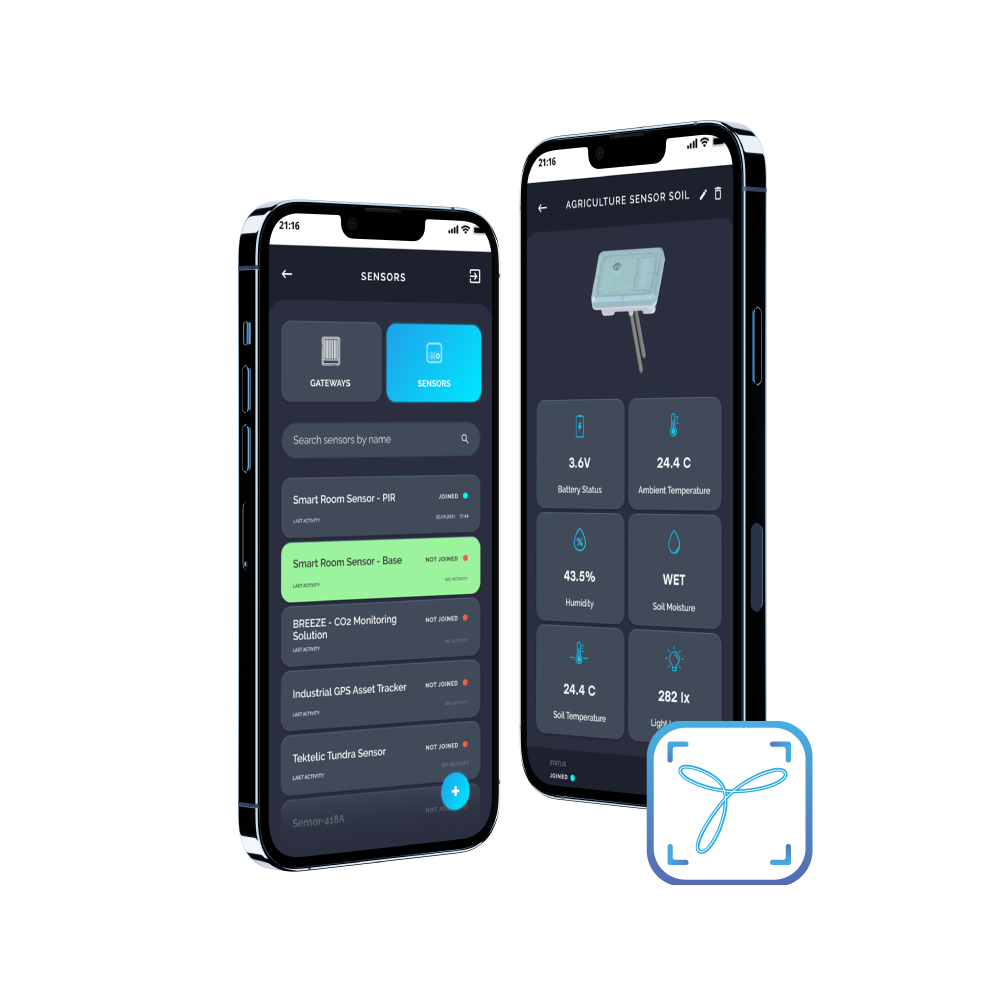KIWI AGRICULTURE SENSOR
Versatile soil and ambient environment sensor for smart agriculture deployments
IP 67
Up to 10 Years

Soil Moisture and Temperature
Ambient Humidity and Temperature
Movement or Orientation Change Detection
Light Detection and Measurement
Light Detection and Measurement
Soil Moisture and Temperature
Ambient Humidity and Temperature
Movement or Orientation Change Detection
Light Detection and Measurement
Works Best for
The KIWI Sensor is ideal for various agricultural applications. It provides valuable environmental metrics leading to increased yields and decreased operating expenses.
key verticals
Precision Agriculture
Irrigation Management
Crop and Soil Metrics
Precision Agriculture
The KIWI Sensor enables precision agriculture by providing accurate soil moisture and temperature data, allowing for optimized irrigation management and efficient crop growth. Maximize yields while conserving resources with the help of KIWI.


Irrigation Management
Efficiently manage irrigation with the KIWI Sensor, which provides real-time soil moisture data. Ensure plants receive the right amount of water at the right time, leading to improved water usage, reduced costs, and healthier crops.


Crop & Soil Metrics
KIWI offers comprehensive monitoring of soil moisture, temperature, and other environmental metrics. Gain valuable insights into crop performance, optimize growing conditions, and make data-driven decisions for increased agricultural productivity.


KIWI benefits
01
01
Long Battery Life
KIWI is designed to provide a battery life of up to 10 years. It ensures continuous monitoring without frequent battery replacements, reducing maintenance costs and minimizing the risk of data loss.
Ruggedized Design
With its IP-67 enclosure, KIWI can withstand harsh outdoor conditions, making it suitable for various agricultural environments. Its rugged design ensures reliable operation and durability in challenging situations.
Easy Deployment
Easy Deployment The KIWI Sensor offers straightforward deployment, allowing for quick and efficient installation. With an optional external antenna, it provides flexibility in antenna placement to optimize signal reception.
Open Integration
KIWI supports open integration with third-party applications through its readily available API. It allows using the sensor's data in conjunction with existing applications for enhanced analytics and decision-making.
01
01
Transforming Agriculture with Precision
The KIWI Agriculture Sensor simplifies the collection of crucial soil and environmental metrics, driving informed decisions for improved agricultural productivity.

01
01
Cultivate Intelligence with Precision
Unleash the power of precision agriculture with TEKTELIC KIWI, a cutting-edge sensor seamlessly monitoring soil and ambient conditions, cultivating the future of intelligent and sustainable farming practices.
MAIN FEATURES
- 10 Year Battery Life
- IP67 Design
- Internal or Optional External Antenna
- C Cell LTC Battery
- Battery Status Indicator
- All Global ISM Bands
- Elevated Mounting Option with External Probes
Differentiations
- Fully Wireless: Battery operated and fully wireless gives the user the convenience and flexibility to deploy the device anywhere without needing access to power.
- Multiple Sensing Functions: Single device monitors soil moisture (tension), soil temperature, ambient temperature and humidity and sunlight (LUX).
- Simple Onboarding: Can be onboarded in seconds by anyone regardless of their technical expertise with TEKTELIC LeapX application.
- Open Integration: API is readily available for anyone to integrate the device with other 3rd party Applications.
MAIN FEATURES
- 10 Year Battery Life
- IP67 Design
- Internal or Optional External Antenna
- C Cell LTC Battery
- Battery Status Indicator
- All Global ISM Bands
- Elevated Mounting Option with External Probes
Differentiations
- Fully Wireless: Battery operated and fully wireless gives the user the convenience and flexibility to deploy the device anywhere without needing access to power.
- Multiple Sensing Functions: Single device monitors soil moisture (tension), soil temperature, ambient temperature and humidity and sunlight (LUX).
- Simple Onboarding: Can be onboarded in seconds by anyone regardless of their technical expertise with TEKTELIC LeapX application.
- Open Integration: API is readily available for anyone to integrate the device with other 3rd party Applications.
TECHNICAL CHARACTERISTICS
Operational Temperature
-40°C to +65°C
RF Power
Up to 23 dBm (200mW)
Ingress Protection
IP67
Battery
C Cell LTC
Antenna
Internal or Optional External
RF Sensitivity
-137dBm (SF12, 125kHz)
Battery life
Up to 10 Years
All Global ism bands
All Global ISM Bands
Dimension
120 x 93 x 58 mm
Empower Your Business Growth with a Trusted Supplier of LoRaWAN® Solutions

Why Choose
TEKTELIC Devices
TEKTELIC offers top-of-the-line LoRaWAN® gateways, sensors, and custom applications. These products, when combined, create a robust end-to-end solution that can be deployed efficiently and cost-effectively to tackle even the most complex IoT challenges.









01
01

